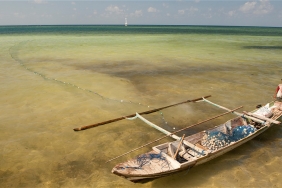TIGER SHRIMP REVIVAL WORKSHOP IN COMMUNITY PONDS
Author: Mohammad Budi Santosa
On October 21, 2015, WWF-Indonesia was invited by the Center for Brackish Water Aquaculture (BBPBAP) Jepara to attend a workshop on the Revival of Tiger Shrimp in People's Ponds. The event, which was accompanied by Training and Assistance of Crab Hatchery Skills, aimed to motivate the tiger shrimp pond and crab hatchery business actors to be passionate in managing their business.
The event was attended by around 250 invitees from BBPBAP Jepara's shrimp farming groups, crab business associations, DKP Provincial and Regency / City in Central Java, universities in Central Java such as UGM, UNDIP and Unisnu Jepara, and shrimp processing company PT Misaja Mitra Pati. Meanwhile, WWF-Indonesia was the only NGO invited to the event.
Wind Shrimp Revival Workshop
The event began with a field visit, inviting participants to see the harvest of tiger shrimp in community ponds managed by intensive methods to see how tiger shrimp hatcheries and recognize how to hatch and cultivate crabs in the BBPBAP Jepara complex. This was followed by a workshop on restoring the glory of tiger shrimp in community ponds, which was held in the BBPBAP Jepara hall.
Head of BBPBAP Jepara, I Made Suitha, APi, representing the Director General of Aquaculture of KKP said that shrimp farming is a promising business because it only requires a fast turnaround time, which is about 3-4 months. However, because of the many problems that have not been resolved, the business is increasingly abandoned.
Ignorance of the principles of aquaculture that balance between business interests and environmental sustainability can lead to disease attacks. This has led shrimp farmers, especially in Java, to stop their business because the yields are not able to cover operational costs. Therefore, BBPBAP Jepara continues to develop shrimp farming technologies and innovations in order to help shrimp farmers restore the glory of tiger shrimp.
Dr. Made L. Nurdjana, a researcher who is also the former Head of BBPBAP Jepara motivated shrimp farmers to continue to increase shrimp production through good traditional pond management. Cultivation standards that have been issued by the government should be the basic principles carried out by farmers so that their yields can increase. For ponds in Java, there is no other way to increase shrimp production other than using technology and aquaculture innovations such as those carried out at BBPBAP Jepara.
These results are due to environmental conditions in Java Island is not like the 70-90s, where increased production can still be by extensification. The success in bringing up hatchery technology with ablation methods, stocking density settings, cultivation system management and waste control is a breakthrough made by the government through BBPBAP Jepara to help shrimp farmers in Indonesia. In traditional ponds, according to him, there is no other way but to continue to develop tiger shrimp because this species is an indigenous species that has proven successful in surviving in Indonesia, both if cultivated in traditional and intensive ways through good cultivation from upstream to downstream if tiger shrimp are to continue to fly in Indonesia.
Preserving Tiger Shrimp
During the discussion, WWF-Indonesia's Fisheries Officer, M Budi Santosa also talked about the importance of preserving tiger shrimp as a native species of Indonesia from the "attack" of vanamei shrimp. For example, in East Kalimantan and North Kalimantan, tiger shrimp is still struggling to maintain its status as the only species that is cultivated. Although there are no regulations prohibiting the breeding of vanamei shrimp in Indonesia, the development of vanamei shrimp tends to be vulnerable to disease attacks.
Farmers in both provinces are concerned about the arrival of vanamei shrimp because it will have an impact on the sustainability of tiger shrimp farming. Shrimp farmers in both areas still believe that tiger shrimp can improve their welfare, given its wide open market abroad.
WWF-Indonesia, which has been working in North Kalimantan, continues to assist farmers and processing companies to apply tiger shrimp farming principles that have been set by both the government and foreign markets.
One of the obstacles faced by farmers in North Kalimantan is the limited availability of good quality tiger shrimp fry. The need for fry in North Kalimantan, which reaches around 70 million, can only be met by local hatcheries of around 40-50 percent. As a result, the shortage is imported from Java Island with the risk of unclear traceability.
For this reason, WWF-Indonesia together with representatives of BBPBAP Jepara, DKP Prov. Kaltara and DKP Tarakan City have proposed that the shortage of shrimp fry in Kaltara can be provided by BBPBAP Jepara with the mechanism of opening a sales shop in Tarakan City. And DKP Tarakan is willing to facilitate if it can be applied. The Head of BBPBAP Jepara welcomed the proposal to help the development of tiger shrimp in North Kalimantan.
At the end of the event, I Made Suitha, Made L. Nurdjana and Ketut Sugama had lunch with the ranks of Jepara Kota Police, Jepara Koramil, representatives of farmer groups, WWF Indonesia and the Director of PT Misaja Mitra Pati. The dishes served were harvested from the BBPBAP Jepara complex. It is hoped that with the synergy of all good parties, the effort to restore the glory of tiger shrimp can be quickly realized.





